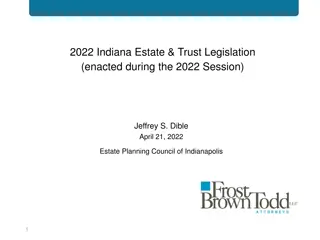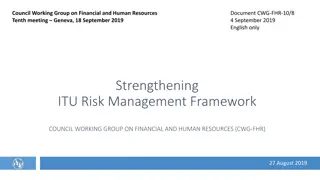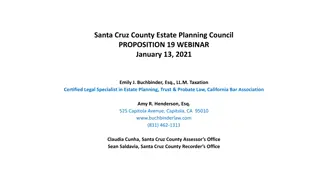Real Estate Investment and Risk Analysis - Spring 2017 Overview
Explore the fundamentals of real estate investment analysis, decision-making strategies, return objectives, and wealth maximization in the context of financial leverage, property types, and investor risk preferences.
Download Presentation

Please find below an Image/Link to download the presentation.
The content on the website is provided AS IS for your information and personal use only. It may not be sold, licensed, or shared on other websites without obtaining consent from the author. Download presentation by click this link. If you encounter any issues during the download, it is possible that the publisher has removed the file from their server.
E N D
Presentation Transcript
REAL ESTATE 410 Investment and Risk Analysis Spring 2017 1
Topics Investment analysis Real estate investment process Computing after-tax cash flows Investment decision rules (NPV, IRR) Sensitivity analysis Partitioning of IRR Financial Leverage Additional investment topics Disposition decision, marginal rate of return, tax-deferral strategies, renovation 2
Introduction What is real estate investment analysis? What is the difference between real estate Investment and valuation? Most of real estate investment principles come from economics and finance. 3
Investment Strategies Investing in Core Properties Investing in Core Properties with a Value Add Strategy Property Sector Investing Contrarian Investing Market Timing Growth Investing Value Investing Strategy as to Size of Property Strategy as to Tenants Arbitrage Investing Turnaround/Special Situations Opportunistic Investing Investing in Trophy or Blue Chip Properties Development 4
Investment Decision Basic question: How to decide whether a specific real estate property constitutes a good investment opportunity for a specific investor (buyer)? There are two key considerations: 1. What financial benefits derived by the investor from owning the property? 2. What are the investor s return objectives, risk preferences, and specific considerations (e.g., income, capital appreciation) 5
Return Objectives An investor s return objective can be: Price appreciation Income flow Both In addition to direct return objective, and investor may also have other objectives, such as: Taxation Diversification Investment preferences, etc. 6
Return Objectives An investor s return objectives can generally be narrowed down to that of wealth maximization. In general, real estate investors (like any other investors) seek to accumulate wealth whileminimizing the amount of risk they face. However, wealth maximization requires that the analysis be conducted at the portfolio level. The analyst should consider how the investment affects the performance of the investor s entire portfolio. 7
What is Investing? Investingis committing current resources, often money, in exchange for future benefits, often cash returns. Often though, future cash flows generated by an investment may be uncertain. There are two levels of uncertainty: The amounts of future cash flows generated by the investment may be uncertain. The timing of those cash flows may be uncertain as well. 8
Risk-Return Tradeoff Assuming normal behavior on the part of investors, it is anticipated that there will be a risk-return tradeoff. Bearing additional risk will take place only under the expectation of additional benefits. The relation between risk and return is therefore expected to be positive. Investors risk preferences plays a key role in the relation. How much risk and return is expected by investors varies with their risk preferences and the market s risk appetite. 9
Parties in RE Investments There are three main parties associated with real estate investments: Equity investor: The residual claimant Owns the property Responsible for keeping the property operational Responsible for servicing any debt Exposed to various risks, some of which unpredictable Debt investor: The mortgage Lender Finance part of the purchase price of the property Maintains interest on financed property Exposed to default and prepayment risks, among others Government: Taxes and regulations 10
Taxation NOI does not consider financing expenses and taxation, all of which may be relevant to someone s investment decision! Investment analysis must consider these issues and other specific investor considerations. Unlike market valuation, investment analysis is investor-specific. Investment decisions should therefore be based on after-tax cash flows (ATCFs), not NOI. Taxes calculations can be relatively complicated! 11
Taxation Tax considerations may make or break a real estate investment opportunity. Real estate investments are taxed at the federal, state, and local levels. Applicable taxes depend on: Type of investment (how it is classified by IRS) Legal structure used for the investment The services of a tax expert is often required for complex real estate transactions. 12
Taxation IRS defines four categories of real estate investments. 1. Property held as personal residence: No depreciation Property taxes and mortgage interest tax deductible Sale or exchange may trigger capital gain tax over a certain amount No like-kind tax-deferred exchange 13
Taxation 2. Property held for sale (dealer properties): No depreciation Gains and losses treated as ordinary income No tax-deferred exchange 3. Property held for investment: Held for capital appreciation, not income (e.g., raw land) Interest payments, up to income, can be expensed, with additional amount capitalized No depreciation Like-kind tax deferred exchange allowed Capital gains and any income are taxed 14
Taxation 4. Property held for use in trade or business: Property not held for sale, but as a factor of production. Rental properties qualify. Tax depreciation is allowed Like-kind tax-deferred exchange allowed Gains and losses on sale may be offset against ordinary income Income-producing commercial real estate properties fall in this category. 15
Taxation IRS tax classifications of property investments are important because they: 1. Determine how income is taxed. Whether income is taxed as personal income 2. Determine if depreciation is allowed. Personal residences, dealer property, and investment property can t be depreciated 3. May affect taxes due on sale. Net gains from sale of trade or business property (held for at least a year) are taxed a capital gain tax rates Net losses on trade or business property are deductible w/o limit against ordinary income. 16
How are Taxes Computed? Taxes are due on both ordinary income and any capital gain (coming later) Taxes on ordinary income: We need to consider: Financing costs (interest expenses, fees, and other commissions) Depreciation expenses (or tax depreciation) Taxes on capital gain: We need to consider: Amount of capital gain realized Any previous reductions in taxes from depreciations (accumulated depreciation) 17
Financing Costs Mortgage interest Generally deductible in the year in which it is paid. Repayment of loan principal Not tax deductible. Up-front financing costs on trade or business properties or investment properties They are amortized over life of loan. If loan is prepaid before up-front costs are fully deducted, remaining cost can be deducted in year of sale. 18
Financing Costs Discount points paid on purchase mortgages Fully deductible in year paid Discount points paid on refinancing mortgages Amortized over life of the loan Other closing costs charged by lenders Added to depreciable basis (i.e., not deductible) E.g., Origination fee, credit checks, property appraisal, lender's attorneys fees Local property taxes Tax deductible (part of operating expenses) 19
Depreciation The rationale for depreciation is that the property is used up in the process of generating income The resulting loss in value should therefore be expensed against the generated income More reason to budget recurring capex by setting up a capex reserves account What determines amount of tax depreciation? Depreciable amount or basis Cost recovery period Method of depreciation 20
Depreciation Basis The original cost basis includes all costs associated with acquiring the property and transferring the title. Land value cannot be depreciated. The depreciable basis is the total value that can be depreciated over the recovery period. Depreciable Basis = Cost Basis Land Value 21
Depreciation Depreciation Depreciable Basis / Recovery Period Recovery period is different based on property type Residential income producing property (27.5 yrs.) Non-residential income producing property (39 yrs.) The recovery period is a product of the tax code. It will vary based on the country that the real estate is located in. 22
From NOI to ATCF Net Operating Income (NOI) - Debt Service (Interest and principal amortization) = Before-Tax Cash Flow (BTCF) - Income taxes (savings if BTCF negative) = After-Tax Cash Flow (ATCF) 23
Income Taxes Net operating income (NOI)* - Interest expenses - Depreciation = Taxable income x Investor s marginal income tax rate = Income tax * NOI is a cash flow item. Any capex reserves should be added back when computing taxes 24
Forecasting ATCFs Since most real estate investments are held for more than 1 year, the typical cash flow analysis is developed for over several years. The planned investment holding period is agreed with the investor and ATCF from rental income (and other ancillary income) is developed for each year. Due to growth and changes affecting several items, ATCFs will vary from year to year in most cases. In addition to periodic ATCFs from rental income, the AT proceeds from the disposal of the property at the end of the investment period must be estimated. 25
Capital Gain Capital gain refers to any gain realized when a property is sold. Capital gain taxes normally includes two parts: Tax on appreciation above the original cost Tax on recaptured depreciation Under current IRS rules, Capital appreciation is taxed at the capital gain tax rate of 15% if the property. Recaptured depreciation expenses is taxed at 25%. 26
Taxes on Property Sale Owners may dispose of properties through Cash sale Installment sale Tax-deferred exchange (sometimes) Full tax is due at time of sale if full payment is received in year of sale (cash sales). Tax payment is deferred if installment sales or tax-deferred exchange. Installment sales: tax is due as payments are received. Tax-deferred exchanges: tax is due when exchange property is sold. All taxes from property sales (i.e., capital gain and recaptured depreciations) must eventually be paid. The only benefit from delayed payment is the time value of money. 27
ATCF from Property Sale Selling price - Selling expenses = Net sales proceeds (NSP) - Capital gain tax - Recaptured depreciation tax - Outstanding mortgage balance = After-tax equity reversion (ATER) We need to compute capital gain and recaptured depreciation taxes? 28
Capital Gain Tax This tax is levied on the appreciation on the value of the property between time of purchase and disposal. The tax is computed as follows: Net sales proceeds (NSP) - Adjusted cost (Purchase price + cost of additional improvements ) = Capital Gain (CG) x CG tax rate = CG tax The CG tax can be positive or negative. 29
Recaptured Depreciation Tax The purpose of this tax is to pay back a portion of income taxes saved through depreciations if the value of the property has not gone down. The recaptured depreciation (RDEP) tax is computed as follows: Accumulated depreciation x Depreciation reversion tax rate = RDEP taxes due on sale Accumulative depreciation is the total amount of depreciations taken throughout the investment holding period. 30
Investment Decision After computing the relevant cash flows: ATCF at the end of each year during the holding period ATER at the end of the holding period The next step is to consider whether the investor should go ahead with the investment opportunity. This decision will depend on the property income-generating potential as well as the investor s specific circumstances. Two traditional decision methods are used: The NPV of cash flows accruing to the equity investor. The IRR earned by the equity investor. 31
NPV Method What is NPV? The NPV of an investment is the net increase in the investor s wealth if the investment is undertaken. NPV is computed by netting off the PV of ATCFs against the PV of investment costs. Often, an investment involves one cash commitment at time t0 and generates periodic cash flows to the investor. But an investment may also involve periodic financial commitments after initiation (e.g., capital additions). NVP analysis estimates the dollar impact of project on investor s wealth. 32
NPV Calculation To find the NPV on the equity investment: 1. Calculate ATCF for each period 2. Calculate ATER at the end 3. Discount these amounts back to today using the investor s required rate of return 4. Subtract the PV of equity investment (I): Usually the purchase price minus the mortgage loan taken, if any. ATCF + ATER + ATCF + ATCF + = + + + + NPV I n n n n 1 2 2 r r r r (1 ) (1 ) (1 ) (1 ) 33
NPV Decision Rule Based on NPV calculation: If NPV > 0 Do the investment because it is expected to generate more than your required rate of return. If NPV = 0 Do the investment because it is expected to exactly generate your required rate of return. If NPV < 0 Decline the investment because it is expected to generate less than your required rate of return. 34
NPV Method What factors may cause NPV to be positive and the investment to turn out bad ex-post? Optimistic cash flows High rental projections Low projected operating expenses Missed capital expenditures High expected resale price Low discount rate Positive NPV projects exist, but are rare. Be careful, RE asset markets are relatively efficient! 35
IRR Method What is IRR on equity? The IRR is the rate of return that will make the investor indifferent between doing or not doing the investment. It is therefore the discount rate that equalizes the PV of ATCFs and the PV of investment costs. The IRR is therefore the discount rate that makes NPV = 0. This is normally referred at as the after-tax IRR. The calculation can also be done on a before tax basis 36
IRR Calculation To find the IRR on Equity: 1. Calculate ATCF for each period 2. Calculate ATER 3. Find the discount rate that makes the PV of the above cash flows equal to the equity put in by the investor, i.e., the makes NPV = 0. 4. This rate is the IRR of the investment! ATCF IRR + ATER IRR + ATCF IRR + ATCF IRR + = + + + + = NPV I n n 0 1 2 n n 2 (1 ) (1 ) (1 ) (1 ) 37
IRR Decision Rule If IRR > r, the required return on equity, then do the investment If IRR = r still do the investment If IRR < decline the investment If NPV and IRR lead to opposite decisions, follow the NPV rule. NPV rule always gives the right investment decision. IRR results can vary depending on timing of and variations in cash flows. 38
Example You are exploring to purchase this office property: NOI is $60,000 at the end of year1, increasing at 5% per year Purchase price is $720,000, with improvements representing 80% of the purchase price Depreciation: 39 years Financing: $504,000 loan using a 30-year FRM at 8% compounded monthly You expect to sell the property at the end of year 4 for $860,000, excluding 4% selling expenses Your after-tax required rate of return on equity is 14% Income tax rate is 28%, CG tax is 20%, and RDEP tax is 25% Using the NVP approach, should you undertake this investment? What about if your required rate of return is 18%? What is the IRR of this investment? 39
Example AFTER TAX CASH FLOWS YEAR 1 60,000 (14,769) (40,168) 5,063 (1,418) YEAR 2 63,000 (14,769) (39,818) 8,412 (2,355) YEAR 3 66,150 (14,769) (39,440) 11,941 (3,343) YEAR 4 69,458 (14,769) (39,030) 15,658 (4,384) NOI Depreciation Interest expense Taxable Income Income Tax NOI DS Income Tax ATCF 60,000 (44,378) (1,418) 14,204 63,000 (44,378) (2,355) 16,266 66,150 (44,378) (3,343) 18,428 69,458 (44,378) (4,384) 20,695 40
Example AFTER TAX EQUITY REVERSION Selling price Selling expense NSP Purchase price Capital Gain CG Tax 860,000 (34,400) 825,600 (720,000) 105,600 (21,120) Accumated depreciation RDEP Tax 59,077 (14,769) NSP CG Tax RDEP Tax Mortgage balance ATER 825,600 (21,120) (14,769) (484,944) 304,767 41
Example NPV CALCULATIONS: YR 0 YR 1 14,204 YR 2 16,266 YR 3 18,428 YR 4 325,462 ATCFs PV ATCFs at 14% Equity Investment (I) NPV at 14% 230,115 (216,000) 14,115 NVP IS POSITIVE. DO PROJECT! NVP at 18% (13,194) DON'T DO IT IRR CALCULATIONS: YR 0 YR 1 14,204 YR 2 16,266 YR 3 18,428 YR 4 325,462 ATCFs (216,000) IRR 16% 42
Investment Outcome Remember, NPV and IRR calculations are based on expected cash flows. Realized cash flows may be higher or lower, resulting in the profitability of the investment being higher or lower than initially projected. The investment decision is an ex-ante decision, whereas the investment successis appreciated ex-post. 43
Sensitivity Analysis Commonly called what if analysis, a sensitivity analysis evaluates the impact of assumptions on the investment decision. It answers how sensitive the results are to different input errors or assumptions. For example, what is the impact of lower rent growth or rent remaining flat on the viability of the investment? What about unexpected large CAPEX? As an exercise, examine the impact of changes in various assumptions on NPV and IRR in the previous example. 45
Sensitivity Analysis Base Case Frame of reference for analysis Change a single assumption What is effect on NPV or IRR? Scenario Analysis Change multiple assumptions at once Identify most likely, pessimistic, and optimistic scenarios 46
Problems with IRR IRR analysis is fraught with potential problems: Multiple solutions: Normally, IRR calculation should yield a unique rate of return. But in some cases, the solution is not unique. It may yield a positive and a negative rate of return. This is often due to cash flows changing signs, going from positive to negative. Use the positive value of IRR in this case. 47
Problems with IRR Investment ranking problem: Sometimes, NPV and IRR analyses may rank two independent investments differently. This is often the case when: The scales of the projects are not the same, i.e., large vs. small projects. When the cash flow patterns are not the same, i.e., early large cash flows vs. even or future large cash flows. If this happens, again base your decision on NPV calculation. 48
Problem with DCF Method DCF method only analyzes whether it is optimal to undertake a project now or not to do it at all But the DCF method does not integrate the fact that it is generally possible to delay a project In most cash having the option to delay a project is quite valuable and must be considered Why? Basically, we need to price the option to delay the project. The price of an option being always positive, a project should only be green lighted if its NPV is greater than the value of the option to delay 49
Partitioning IRR IRR on a real estate investment comprises of two sources of cash flow: Cash flow from operations (income return) Cash flow from the resale of the property (appreciation return) It is important to know how much of IRR is coming from these two sources because they have different levels of risk We will partition IRR into two parts based on these two types cash flow. Consider the following investment. 50



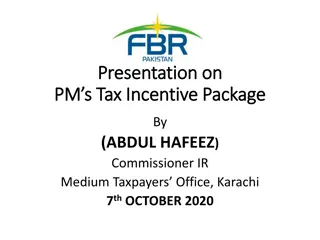





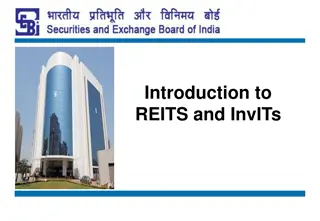











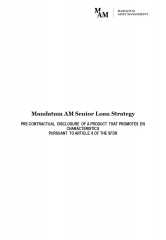

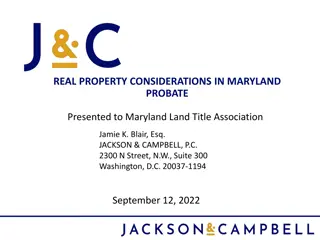
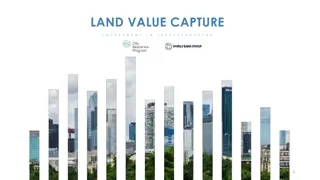


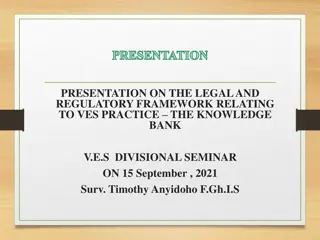
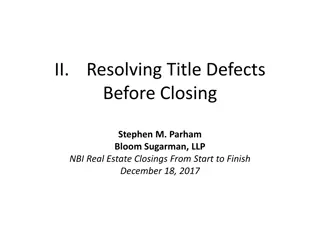






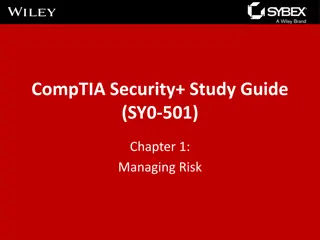
![Town of [Town Name] Real Estate Tax Rates and FY 2024 Budget Summary](/thumb/62211/town-of-town-name-real-estate-tax-rates-and-fy-2024-budget-summary.jpg)

